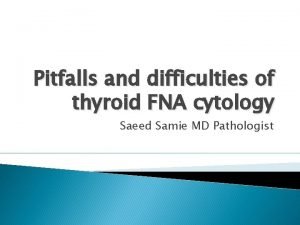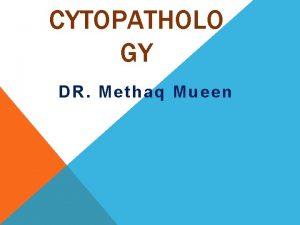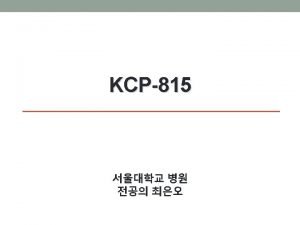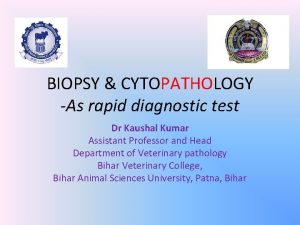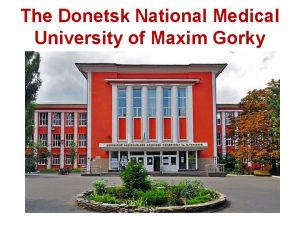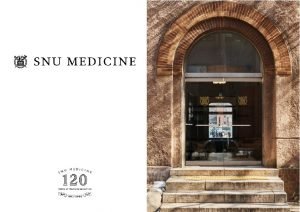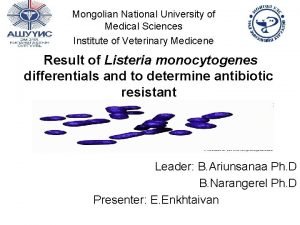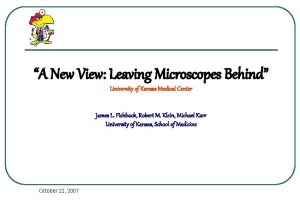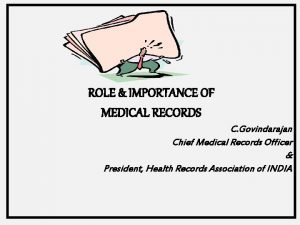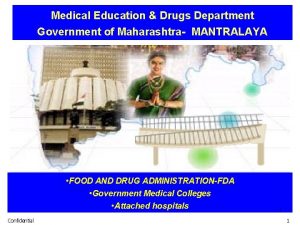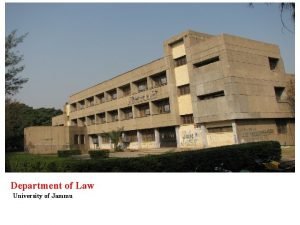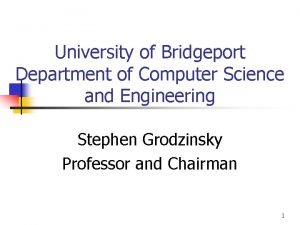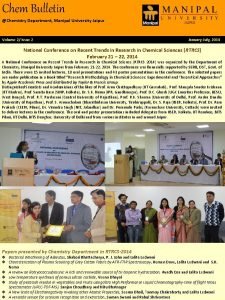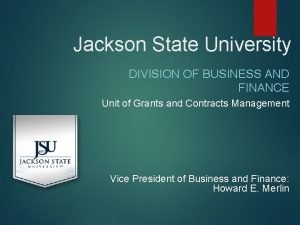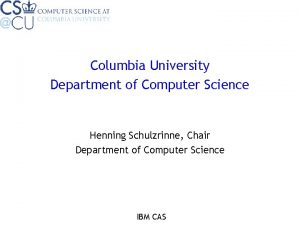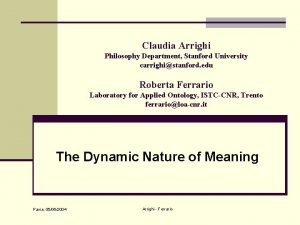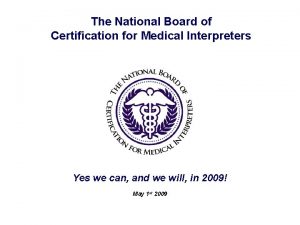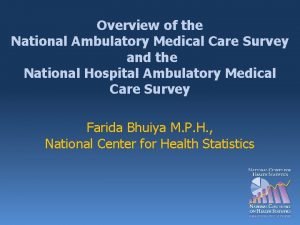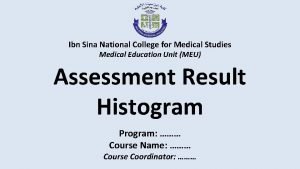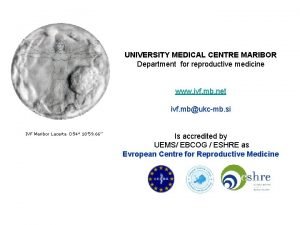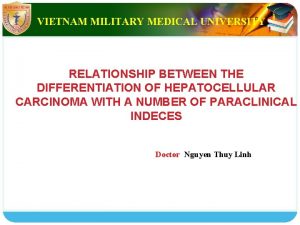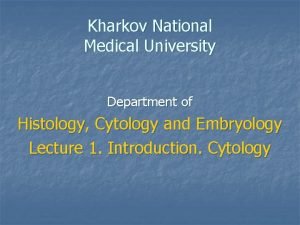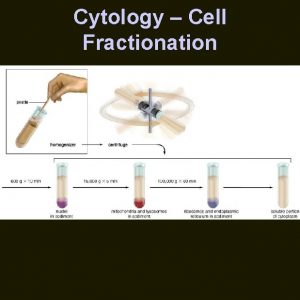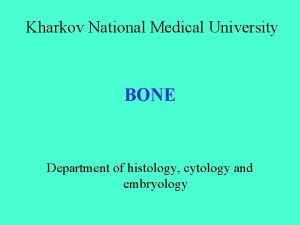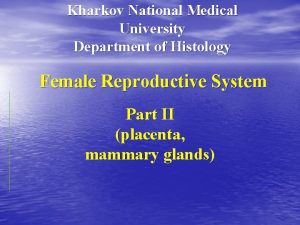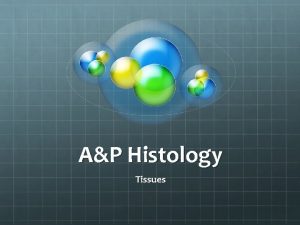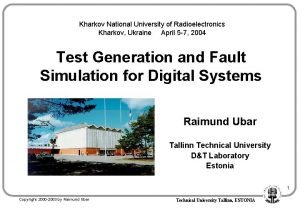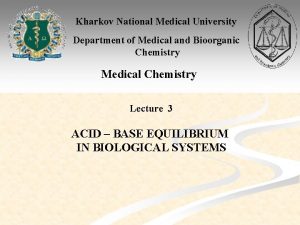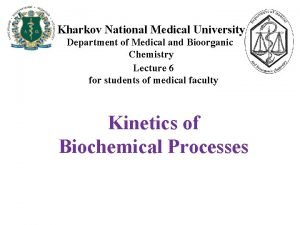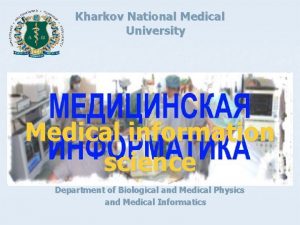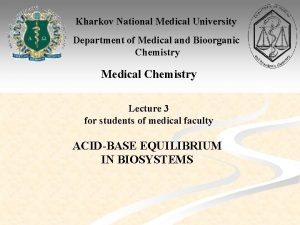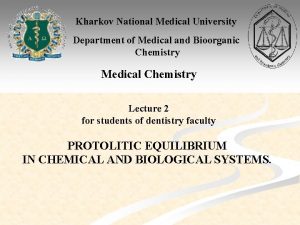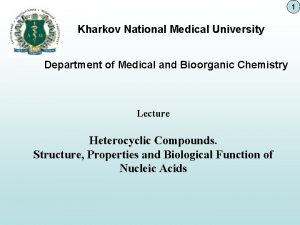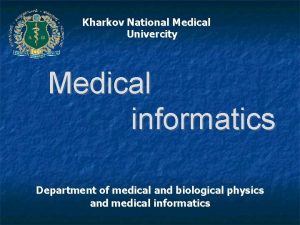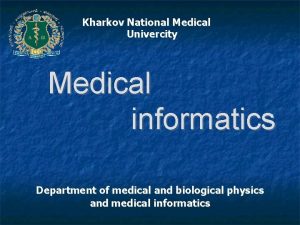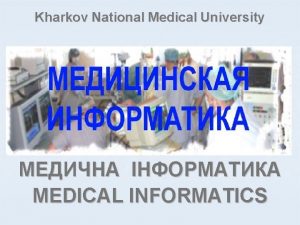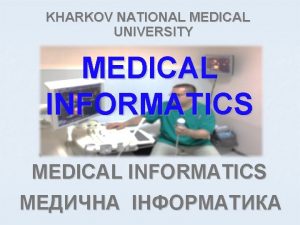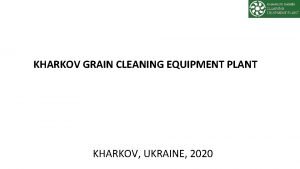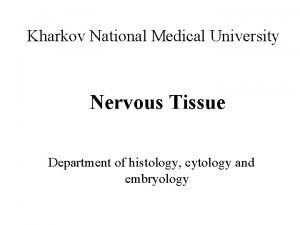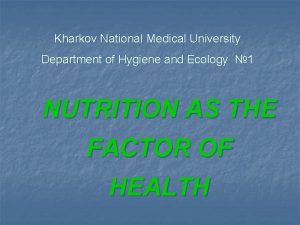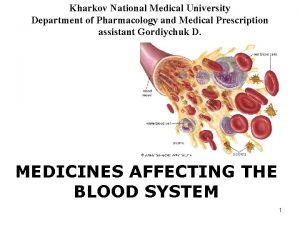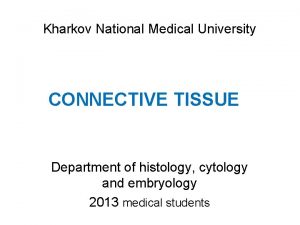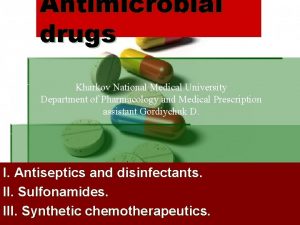Kharkov National Medical University Department of Histology cytology











































- Slides: 43

Kharkov National Medical University Department of Histology, cytology and embryology

HISTOLOGY studies microscopic structure and function of the human organism


is the structural and functional unit of the organism

Structure of a typical cell 1. Cell membrane 2. Nucleus 3. Cytoplasm cytosol non-membranous organelles

Biological membrane Biological Membrane is a structural unit of a cell in the cell membrane, nucleus and some organelles

Cell membrane (plasmalemma). Outer is glycocalyx

Non-membranous Organelles u 1. Cytoskeleton is the system of microtubules

2 centrioles – consist of 9 triplets of microtubules. Formation of mitotic spindle 2. Cell center

3. Ribosomes two subunits synthesize proteins; Fixed on RER, or free ribosomes

Membranous Organelles

1. Mitochondrion (two membranes) synthesis of energy - ATP

2. Endoplasmic reticulum (net of membranes) smooth (SER) & rough (RER) RER contains ribosomes SER Function: Synthesis Storage Transport SER of lipids and carbohydrates RER of proteins

3. Golgi Apparatus Packaging of proteins, formation of lysosomes, secretion, formation of compound molecules – glycoproteins, lipoproteins

4. Lysosome is digestive apparatus, contains enzymes (autolysis)

Intercellular Junctions 1) Gap Junction has channel proteins

2) Tight Junctions Interlocking proteins

3) Desmosomes STRONG BOND Found in superficial layers skin of

INCLUSIONS are nonliving components of a cell like: secretory granules, pigment, lipid, glycogen

Nucleus – contains genetic information

Cell Cycle _ _ _ The life of a somatic cell is a cyclic process - cell cycle consists of two periods: interphase and mitosis. interphase contains G 1, S, G 2 stages

CELL CYCLE: Stages G 1 Gap 1 S G 2 M G 1 Go growth, DNA Synthesis function (for new cells) stem Gap 2 formation of m. spindle, energy Mitosis or for Gap 1 for a new differen cycle tiation

Mitosis _ Mitosis is the process of somatic cells division. _ Mitosis consists of : prophase, metaphase, anaphase, telophase. _ _

Prophase _ Chromosomes become more coiled and visible _ the nuclear membrane breaks down _ Microtubules of centrioles form a spindle of division. Ch

Metaphase _ - chromosomes move to the center of the cell and form the equatorial plate Ch

Anaphase _ - the chromosomes separate and move to opposite poles of the cell Ch

Telophase _ - two daughter nuclei are formed. _ the chromosomes uncoiledand become indistinct.

EMBRYOGENESIS IS FORMATION OF THE HUMAN ORGANISM

Week 1 _ 1. Fertilization – is the fusion of the sperm and ovum = Zygote formation _ 2. Cleavage – is the division of the zygote in the uterine tube = Blastula formation

Week 1 Cleavage 2 cells stage 3 -5 cells stage Morula Blastula . . uterine tube zygote Fertilization uterus Implantation Day 6 - 8

At the end of cleavage outer cells (trophoblast) involve nutritive fluid, which forms cavity, moving inner cells (embryoblast). Blastula is formed. Inner Cell Mass (embryoblast) Trophoblast

Week 2. 3. Early Gastrulation (division and movement of cells). At the beginning of gastrulation (6, 7 day) germ sinks into the uterine wall – implantation. Gastrulation leads to formation of three germ layers – ectoderm, endoderm and mesoderm and extraembryonic organs: amnion, yolk sac chorion

Week 2 Ectoderm chorion amnion Endoderm yolk sac Extraembryonic Mesoderm of Amnion and Yolk Sac

Gastrulation is finished with the formation of axial organs – neural tube, notochord, somites (mesoderm), locating between ectoderm and endoderm. From them develop tissues and organs! Neural tube Somate amnion ectoderm endoderm yolk sac Notochord

4. Body flexion (amnion increases and forms body)

Body flexion formation (Gut formation. Gut is the upper part of yolk sac) longitudinally transversely gut head right left

Differentiation of germ layers and axial organs _ What develops from them?

Surface Ectoderm differentiates to skin, oral, rectal epithelium, corneal epithelium, tooth enamel amnion stomatodeum ectoderm

Endoderm differentiates to epithelium of stomach, intestine, liver, pancreas, respiratory, endocrine system -- 3 -4 weeks - gut endoderm gut

Extra mesoderm- formation of the first blood vessels in the wall of yolk sac and allantois blood vessels

Body Mesoderm urogenital system including kedneys, gonads, ducts, and accessory glands 3. Intermediate Mesoderm. Nephrotome dermatome - dermis of skin 1. Somitemyotome - muscles, sclerotome skeleton, except skull, 2. Lateral Mesoderm serous membranes of pleura, pericardium and peritoneum 4. Mesenchyme (loose part) – connective tissue of viscera and limbs, blood and lymph cells, vessels, smooth muscle

Late embryonic stages _ _ Histogenesis Organogenesis

 Bethesda thyroid cytology
Bethesda thyroid cytology Abrasive cytology definition
Abrasive cytology definition Proteinaceous background
Proteinaceous background Exfoliative cytology
Exfoliative cytology Cell biology and cytology
Cell biology and cytology Exfoliative cytology
Exfoliative cytology Gadolinium mrt
Gadolinium mrt M.gorky donetsk national medical university
M.gorky donetsk national medical university Seoul national university history
Seoul national university history Mongolian national university of medical sciences
Mongolian national university of medical sciences Ku medical center histology slides
Ku medical center histology slides Patient rights and responsibilities nabh
Patient rights and responsibilities nabh Medical education and drugs department
Medical education and drugs department National risk and resilience unit
National risk and resilience unit 6 priorities of the department of health
6 priorities of the department of health Function of national audit department in malaysia
Function of national audit department in malaysia Department of law university of jammu
Department of law university of jammu Department of geology university of dhaka
Department of geology university of dhaka University of padova psychology
University of padova psychology University of bridgeport it department
University of bridgeport it department University of iowa math
University of iowa math Sputonik
Sputonik Texas state university psychology
Texas state university psychology Department of information engineering university of padova
Department of information engineering university of padova Information engineering padova
Information engineering padova Manipal university chemistry department
Manipal university chemistry department Syracuse university pool
Syracuse university pool Jackson state university finance department
Jackson state university finance department Computer science department columbia
Computer science department columbia Msu physics and astronomy
Msu physics and astronomy Columbia university cs department
Columbia university cs department University of sargodha engineering department
University of sargodha engineering department Stanford university philosophy department
Stanford university philosophy department Doctors license number
Doctors license number Gbmc medical records
Gbmc medical records Hepburn osteometric board
Hepburn osteometric board Torrance memorial hospital medical records
Torrance memorial hospital medical records Cartersville medical center medical records
Cartersville medical center medical records National board of medical interpreters
National board of medical interpreters National ambulatory medical care survey
National ambulatory medical care survey Ibn sina national college for medical studies
Ibn sina national college for medical studies Ivf maribor
Ivf maribor Liaoning medical university
Liaoning medical university Vietnam military medical university
Vietnam military medical university
